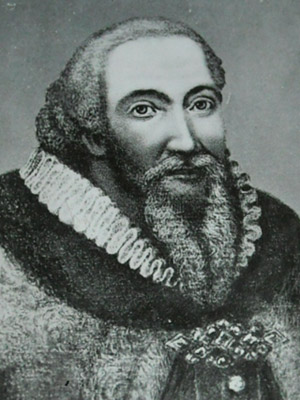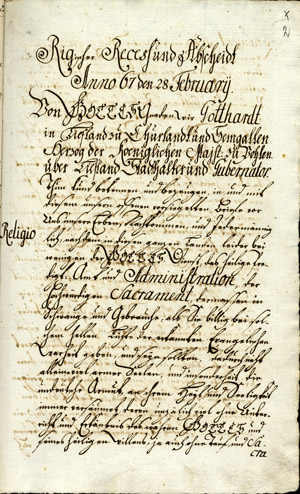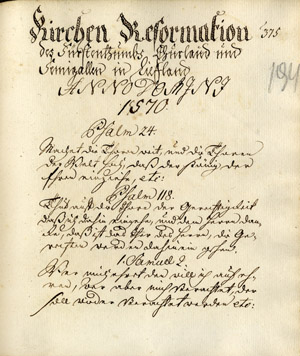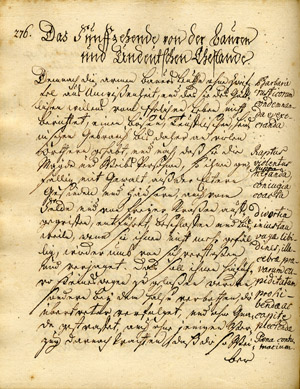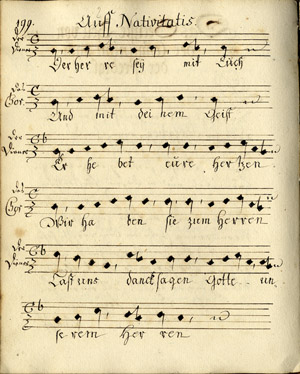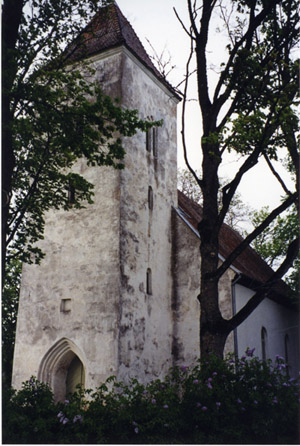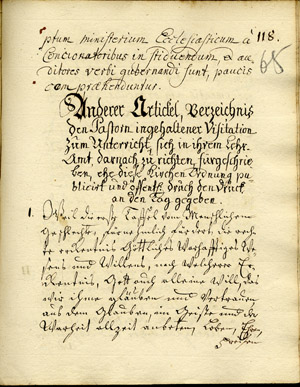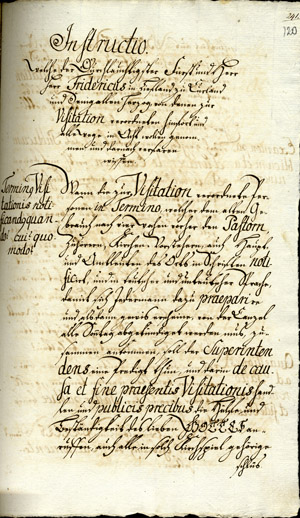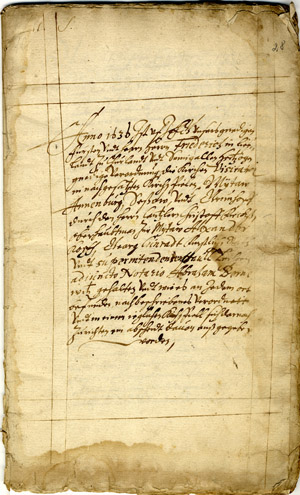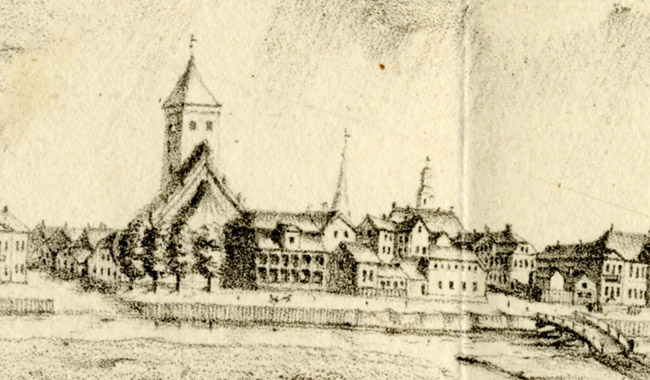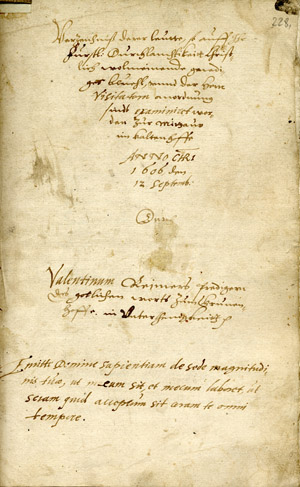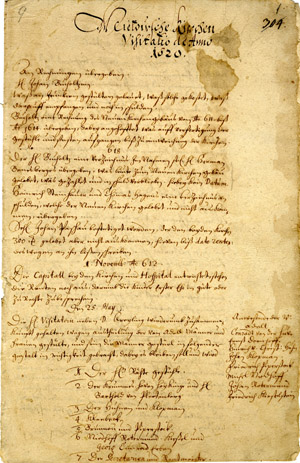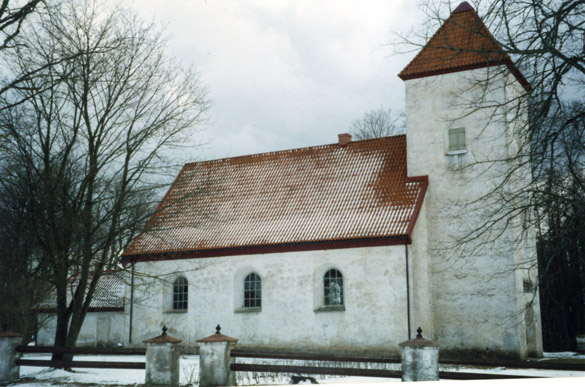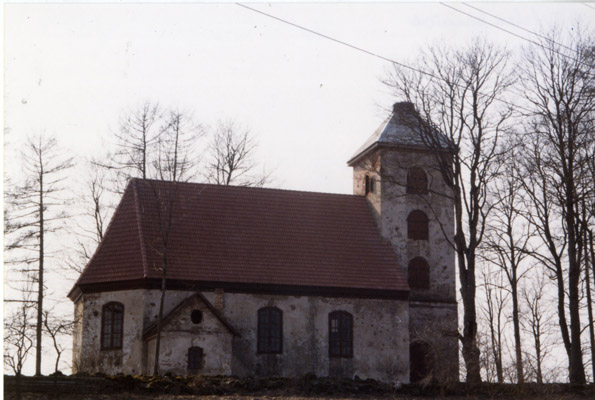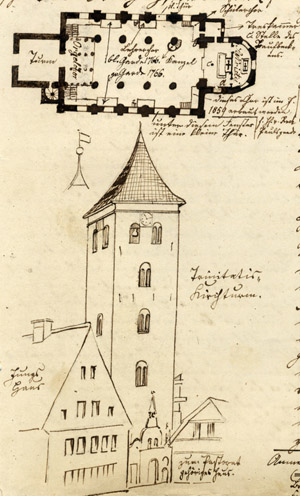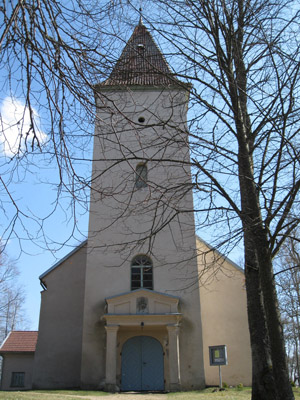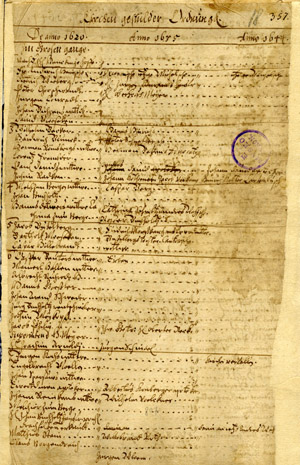The church
In contrast to the Middle Ages, when the state served religion, the Early Modern Era brought a different approach. The ruler’s authority was based on the ‘Grace of God’ and religion became one of the political instruments of the state. In the Duchy of Courland, too, the Church served to strengthen the power of the duke and became the link between the nobility and the duke. It is not known exactly when Gotthard Kettler and his associates converted to Lutheranism, but in the Pacta Subiectionis the King of Poland, a Catholic, effectively recognised Lutheranism as the official faith of the new duchy. Catholicism was not forbidden in Courland at that time, but was not promoted in any way. Under the direction of Gotthard, the organisational structure of the Evangelical Lutheran Church in the duchy was established, with the duke as the head of this organisation. Since one of the demands of the Reformation had been for services and sermons to be held in a language comprehended by the population, Duke Gotthard ordered the translation into Latvian and printing of religious texts and hymns.
1. Gotthard Kettler.
2. Decision of the Diet of the Duchy of Courland. Riga, 28 February 1567. Excerpt. LVVA, Collection 640, Inventory 3, File 626.
The earliest known decision by the Diet (Landtag) of the Duchy of Courland, in which the duke and the nobility were represented. It stipulated the dues to be paid for the maintenance of churches and listed the locations where churches, schools and almshouses were to be established or re-established. Only copies of the agreement survive, and the number of churches mentioned in them varies, depending on the punctuation used by the copyist. Although the literature most commonly mentions a figure of 70 churches, most of the copies actually list 58.
3. “Reformation of the Church of Courland and Semigallia”. Title page. 1570. LVVA, Collection 4038, Inventory 2, File 930.
Matters relating to the church were also discussed at the 1570 sitting of the diet, held in Mitau/Jelgava. After the meeting of the diet, Gotthard not only issued a confirmation of the privileges of the nobility, but also brought together in a separate text the most important tasks relating to the establishment of the structure of the Church and Christian morality, referring to this as a “Reformation of the Church”. Among other things, the duke urged that “the shameful ingratitude towards the old and infirm, widespread among the non-German population” should be brought to an end, and that the peasants should be made to care for their infirm family members. Hospitals and almshouses were to be built for German poor and beggars.
4. “Church Laws of the Duchy of Courland”. Title page. 1570. LVVA, Collection 4038, Inventory 2, File 930.
The Church Laws of the Duchy of Courland detailed the principles already established in the “Church Reformation”. The laws were written by Alexander Einhorn (?1575), Gotthard’s court pastor and superintendent. The laws laid down the procedure for appointing pastors and for church inspections, as well as the content of services, church ceremonies etc. Special attention was also given to non-German (Latvian) congregations. The “Church Laws of the Duchy of Courland” were first printed in Rostock in 1572, but in many churches they were kept as handwritten copies. These laws remained in force until 1832.
5. “Church Laws of the Duchy of Courland”. 1570. Excerpt. LVVA, Collection 4038, Inventory 2, File 930.
The social disciplining of society and instilling of Christian morality was one of the main aims of the Evangelical Lutheran Church. Accordingly, the Church Laws not only laid down the procedure for sermons, but also regulated wedding, christening and funeral ceremonies. There is a separate section devoted to marriage among the peasantry, specifically condemning the “devilish custom” of stealing brides. Henceforth it was a capital offence.
6. Music for a Christmas hymn. Excerpt from the “Church Laws of the Duchy of Courland”. 1570. LVVA, Collection 4038, Inventory 2, File 930.
Hymns were to become a significant element of the liturgy, so Einhorn included several example songs in the laws, and these were to be sung on particular feast days.
7. Wahnen/Vāne Church.
8. “Church Laws of the Duchy of Courland”. 1570. Excerpt. LVVA, Collection 4038, Inventory 2, File 930.
One of the declared tasks of the new church was to struggle against the pagan practices (heidnische Abgotterey) of the population, especially the Latvians. Thus, pastors were to see that peasants did not feed the spirits of the dead (Dwessel Meley) between St Michael’s Day and All Saints’ Day. Offerings of wax, candles, wool, hens, eggs, butter etc. were also forbidden.
9. Instruction by Duke Frederick to church inspectors. Annenburg/Emburga, 10 September 1636. Copy. LVVA, Collection 640, Inventory 3, File 626.
In the course of the inspection it was necessary to check how the pastor was discharging his duties, whether the congregation was practicing a Christian way of life, what condition the buildings were in etc. In order to improve supervision of the activities of pastors, it was decided in 1636 to appoint deans in Selburg/Sēlpils, Bauske/Bauska, Doblen/Dobele, Goldingen/Kuldīga, GrobinGrobiņa and Kandau/Kandava. In Mitau/Jelgava, the functions of dean were fulfilled by the superintendent. At the same time a general church inspection was also announced, the task of which was to ascertain the condition of Church affairs after the Polish-Swedish War. The instruction to the inspectors, signed by the duke, repeated the points previously formulated in the Church Laws and set out certain points in more detail.
10. Record of an inspection of the parishes of Mitau/Jelgava, Annenburg/Emburga, Sessau/Sesava and Grünhof/Zaļenieki. SeptemberOctober 1636. Excerpt. LVVA, Collection 2728, Inventory 8, File 133.
Supreme authority in Church matters was in the hands of the duke, administrative affairs being handled by the consistory, headed by the superintendent. Inspections were generally carried out by the superintendent together with officials appointed by the duke. This particular record is signed by the following inspectors: Christoph Fircks, Chancellor of the Duchy, Alexander Korff, Supreme Captain of Mitau/Jelgava, the duke’s Councillor Georg Künrad and Superintendent Paul Einhorn. Einhorn (?1655) was the grandson of A. Einhorn, who had compiled the Church Laws, and was the first author of “Latvian History” (Historica Lettica, 1649). He was appointed superintendent in early 1636.
11. Detail of a panorama of Mitau/Jelgava town. Second half of the 18th century. Ink drawing. LVVA, Collection 640, Inventory 2, File 262.
Clearly visible in the foreground is the Holy Trinity Church of the German congregation, to the right of which is the spire of the Church of St Anne, belonging to the non-German (Latvian) congregation. In accordance with tradition, the building of churches in the duchy was financed by the congregation, the chancel being paid for by the duke, with the exception of cases where the church was built on private property with money from the landowner. Another exception is the building of St Anne's in Mitau/Jelgava in the late 16th century, financed entirely by Duchess Anna.
12. Record of an examination of the peasants. Kaltenhof/Viskaļi, 12 September 1606. LVVA, Collection 2728, Inventory 8, File 135.
Whenever there was an inspection, and on a yearly basis, the local pastor had to question the peasants of his congregation on their knowledge of the liturgy and religious teachings, and on whether pagan practices were taking place. The record listed the names of the farmers and noted the level of knowledge in the household. For example, the peasant Kenkuss Frederick said that he could recite the Lord’s Prayer, but that his manservants and maidservants did not know prayers. It is recorded that Jeger Matz did not know any prayer, but had recently married. To the question of how he had been able to take a wife without knowing anything of the liturgy, he had answered: “I had need of a wife”. Matz promised to learn prayers, because his wife knew the catechism and the rest of the household knew how to pray. This record also indicates that at that time women were generally more familiar with religious teachings then men.
13. Inspection record of Holy Trinity Church in the town of Mitau/Jelgava, 1620. Excerpt. Copy from the mid-17th century. LVVA, Collection 2728, Inventory 8, File 133.
This is one of the earliest known church inspections in a town. In many cases the inspection records contain various kinds of interesting evidence. For example, the members of the Mitau/Jelgava congregation had asked the duke to allow them to hire a teacher to teach arithmetic and Polish at the school. They were also dissatisfied with the singing teacher, and so the town councillor Mesecke had offered to find a suitable candidate in Germany.
14. Pussen/Puze Church.
15. Strutteln/Strutele Church.
16. List of children christened in the German congregation of Windau/Ventspils, beginning on 13 December 1636. First page. LVVA, Collection 235, Inventory 1, File 220.
Registration of newborn children with the pastor was stipulated already in the 1591 “Regulations on Celebrations” of Duchess Anna, but the earliest registers are preserved from the 17th century. One of the earliest is the Windau/Ventspils register. However, it gives very incomplete information: the date of the christening is recorded, along with the name of the father and the sex of the child, but the names of only some of the children appear.
17. Holy Trinity Church, Mitau/Jelgava, before alteration in the 19th century. Drawing by Julius Döhring. LVVA, Collection 5759, Inventory 2, File 1107.
In sources from the first half of the 17th century the church is generally referred to simply as the “new church”. When they entered Mitau/Jelgava for the second time during the war, in October 1625, the Swedes used it to bombard the castle, built fortifications in the cemetery and broke into some of the vaults in the chancel, robbing the burials. Compared with the Middle Ages, respect for the church as a sacred place had significantly decreased.
18. Virginahlen/Vērgale Church.
19. Division of the pews in Holy Trinity Church, Mitau/Jelgava, in 1620, 1635 and 1644. First page. LVVA, Collection 5759, Inventory 2, File 807.
Each category of residents had its own place in church, which they occupied in accordance with a list compiled by the heads of the congregation and inspectors. The list gave the names of the people who are to sit in each pew. However, in order to receive the allotted place, in accordance with one's social stratum and rank, the person had to pay a certain sum into the church chest. Another way in which the church earned money was through payments for burial places in the church.
